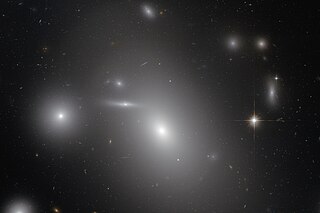Related Research Articles

Fornax is a constellation in the southern celestial hemisphere, partly ringed by the celestial river Eridanus. Its name is Latin for furnace. It was named by French astronomer Nicolas Louis de Lacaille in 1756. Fornax is one of the 88 modern constellations.

A globular cluster is a spheroidal conglomeration of stars. Globular clusters are bound together by gravity, with a higher concentration of stars towards their centers. They can contain anywhere from tens of thousands to many millions of member stars. Their name is derived from Latin globulus. Globular clusters are occasionally known simply as "globulars".

The Andromeda Galaxy, also known as Messier 31, M31, or NGC 224 and originally the Andromeda Nebula, is a barred spiral galaxy with diameter of about 46.56 kiloparsecs approximately 2.5 million light-years from Earth and the nearest large galaxy to the Milky Way. The galaxy's name stems from the area of Earth's sky in which it appears, the constellation of Andromeda, which itself is named after the princess who was the wife of Perseus in Greek mythology.

The Triangulum Galaxy is a spiral galaxy 2.73 million light-years (ly) from Earth in the constellation Triangulum. It is catalogued as Messier 33 or NGC (New General Catalogue) 598. With the D25 isophotal diameter of 18.74 kiloparsecs (61,100 light-years), the Triangulum Galaxy is the third-largest member of the Local Group of galaxies, behind the Andromeda Galaxy and the Milky Way. It is one of the most distant permanent objects that can be viewed with the naked eye.

The Sagittarius Dwarf Spheroidal Galaxy (Sgr dSph), also known as the Sagittarius Dwarf Elliptical Galaxy, is an elliptical loop-shaped satellite galaxy of the Milky Way. It contains four globular clusters in its main body, with the brightest of them – NGC 6715 (M54) – being known well before the discovery of the galaxy itself in 1994. Sgr dSph is roughly 10,000 light-years in diameter, and is currently about 70,000 light-years from Earth, travelling in a polar orbit at a distance of about 50,000 light-years from the core of the Milky Way. In its looping, spiraling path, it has passed through the plane of the Milky Way several times in the past. In 2018 the Gaia project of the European Space Agency showed that Sgr dSph had caused perturbations in a set of stars near the Milky Way's core, causing unexpected rippling movements of the stars triggered when it moved past the Milky Way between 300 and 900 million years ago.

Gaia is a space observatory of the European Space Agency (ESA), launched in 2013 and expected to operate until 2025. The spacecraft is designed for astrometry: measuring the positions, distances and motions of stars with unprecedented precision. The mission aims to construct by far the largest and most precise 3D space catalog ever made, totalling approximately 1 billion astronomical objects, mainly stars, but also planets, comets, asteroids and quasars, among others.
The Canis Major Overdensity or Canis Major Dwarf Galaxy is a disputed dwarf irregular galaxy in the Local Group, located in the same part of the sky as the constellation Canis Major.

The Sculptor Dwarf Galaxy is a dwarf spheroidal galaxy that is a satellite of the Milky Way. The galaxy lies within the constellation Sculptor. It was discovered in 1937 by American astronomer Harlow Shapley using the 24-inch Bruce refractor at Boyden Observatory. The galaxy is located about 290,000 light-years away from the Solar System. The Sculptor Dwarf contains only 4 percent of the carbon and other heavy elements in our own galaxy, the Milky Way, making it similar to primitive galaxies seen at the edge of the universe.

The Milky Way is the galaxy that includes our Solar System, with the name describing the galaxy's appearance from Earth: a hazy band of light seen in the night sky formed from stars that cannot be individually distinguished by the naked eye. The term Milky Way is a translation of the Latin via lactea, from the Greek γαλακτικός κύκλος, meaning "milky circle". From Earth, the Milky Way appears as a band because its disk-shaped structure is viewed from within. Galileo Galilei first resolved the band of light into individual stars with his telescope in 1610. Until the early 1920s, most astronomers thought that the Milky Way contained all the stars in the Universe. Following the 1920 Great Debate between the astronomers Harlow Shapley and Heber Curtis, observations by Edwin Hubble showed that the Milky Way is just one of many galaxies.
The Milky Way has several smaller galaxies gravitationally bound to it, as part of the Milky Way subgroup, which is part of the local galaxy cluster, the Local Group.
In astronomy, the Arcturus moving group or Arcturus stream is a moving group or stellar stream, discovered by Olin J. Eggen (1971), comprising 53 stars moving at 275,000 miles per hour, which includes the nearby bright star Arcturus. It comprises many stars which share similar proper motion and so appear to be physically associated.

NGC 4889 is an E4 supergiant elliptical galaxy. It was discovered in 1785 by the British astronomer Frederick William Herschel I, who catalogued it as a bright, nebulous patch. The brightest galaxy within the northern Coma Cluster, it is located at a median distance of 94 million parsecs from Earth. At the core of the galaxy is a supermassive black hole that heats the intracluster medium through the action of friction from infalling gases and dust. The gamma ray bursts from the galaxy extend out to several million light years of the cluster.
In astronomy, stellar kinematics is the observational study or measurement of the kinematics or motions of stars through space.
An extragalactic planet, also known as an extragalactic exoplanet or an extroplanet, is a star-bound planet or rogue planet located outside of the Milky Way Galaxy. Due to the immense distances to such worlds, they would be very hard to detect directly. However, indirect evidence suggests that such planets exist. Nonetheless, the most distant known planets are SWEEPS-11 and SWEEPS-04, located in Sagittarius, approximately 27,710 light-years from the Sun, while the Milky Way is between 100,000 and 180,000 light years in diameter. This means that even galactic planets located farther than that distance have not been detected.

The 215th meeting of the American Astronomical Society (AAS) took place in Washington, D.C., Jan. 3 to Jan. 7, 2010. It is one of the largest astronomy meetings ever to take place as 3,500 astronomers and researchers were expected to attend and give more than 2,200 scientific presentations. The meeting was actually billed as the "largest Astronomy meeting in the universe". An array of discoveries were announced, along with new views of the universe that we inhabit; such as quiet planets like Earth - where life could develop are probably plentiful, even though an abundance of cosmic hurdles exist - such as experienced by our own planet in the past.

An intergalactic star, also known as an intracluster star or a rogue star, is a star not gravitationally bound to any galaxy. Although a source of much discussion in the scientific community during the late 1990s, intergalactic stars are now generally thought to have originated in galaxies, like other stars, before being expelled as the result of either galaxies colliding or of a multiple-star system traveling too close to a supermassive black hole, which are found at the center of many galaxies.

The MPG/ESO telescope is a 2.2-metre f/8.0 (17.6-metre) ground-based telescope at the European Southern Observatory (ESO) in La Silla, Chile. It was built by Zeiss and has been operating since 1984. It was on indefinite loan to the European Southern Observatory from the Max Planck Institute for Astronomy (MPIA). In October 2013 it was returned to the MPIA. Telescope time is shared between MPIA and MPE observing programmes, while the operation and maintenance of the telescope are ESO's responsibility.
HIP 13044 is a red horizontal-branch star about 2,300 light years from Earth in the constellation Fornax. The star is part of the Helmi stream, a former dwarf galaxy that merged with the Milky Way between six and nine billion years ago. As a result, HIP 13044 circles the galactic center at a highly irregular orbit with respect to the galactic plane. HIP 13044 is slightly less massive than the Sun, but is approximately seven times its size. The star, which is estimated to be at least nine billion years old, has passed the red-giant phase. The relatively fast rotation of the star may be due to having engulfed one or more planets during the red-giant phase.

The Gaia Sausage or Gaia Enceladus is the remains of a dwarf galaxy that merged with the Milky Way about 8–11 billion years ago. At least eight globular clusters were added to the Milky Way along with 50 billion solar masses of stars, gas and dark matter. It represents the last major merger of the Milky Way.
References
- 1 2 Scientific American, "Extragalactic Expat: Newfound Exoplanet Likely Came from Another Galaxy", John Matson , 18 November 2010
- 1 2 "Amina Helmi, the "archeologist of the Milky Way," explains how our own galaxy could unlock the mystery of dark matter". FBBVA. 12 December 2017. Retrieved 7 November 2019.
The idea had already been mooted that the merging of small galaxies could have played a major part in forming today’s giant structures. Helmi developed the tools that were able to test this hypothesis and confirm that it held true, at least for the Milky Way.
- ↑ Skibba, Ramin (10 June 2021). "A galactic archaeologist digs into the Milky Way's history". Knowable Magazine. doi:10.1146/knowable-060921-1 . Retrieved 4 August 2022.
- ↑ Jones, M. I.; Jenkins, J. S. (2014). "No evidence of the planet orbiting the extremely metal-poor extragalactic star HIP 13044". Astronomy & Astrophysics. 562: id.A129. arXiv: 1401.0517 . Bibcode:2014A&A...562A.129J. doi:10.1051/0004-6361/201322132.